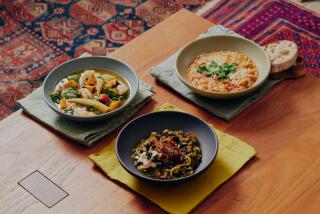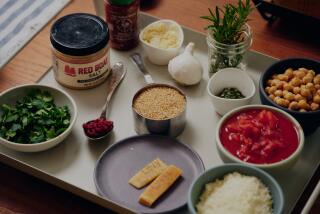Playing it smooth
THE word itself is delicious -- velouté, veh-loo-TAY. If you were in Paris, you’d see them on the menus in bistro after brasserie after restaurant. Velvety, creamy soups, sometimes classic, sometimes more inventive -- chestnut-celeriac with foie gras and cacao, or white bean showered with matchstick-size pieces of black truffle, or a velouté of porcini mushrooms with lardo di Colonnata and fatty-spicy ham from the valley of Les Aldudes in the Pays Basque (poured from a glass carafe at the table, no less).
On a recent wintry day, I spent an afternoon at a bistro by the Seine. Lunch began with a creamy chestnut velouté topped with a fat, toasty griddle cake stuffed with crème fraîche. It was warming, gently rich and deeply satisfying. I then found myself ordering bowlfuls of velouté all over the city.
FOR THE RECORD:
Recipes: The recipes with an article about veloute soups in the Jan. 16 Food section were from to test kitchen director Donna Deane. —
Velouté sounds fancy, but it’s easy enough to make. The point is to get the right consistency -- a not-too-thick, creamy-velvety texture -- as well as concentrated flavor. Knowing the basic construction of velouté lets you improvise with whatever vegetables you happen to have on hand. Try a velouté made with cremini and oyster mushrooms, punctuated with a little garlic and rosemary; or a soulful white-bean soup finished with cream and a little Gruyère cheese. Go elegant with kabocha soup dressed with a dollop of sour cream; slender, buttery croutons; and a light sprinkling of piment d’espelette (dried red Basque chile).
In the fall, definitely chestnut velouté, and in the summer, chilled avocado. Or even a Brazilian-style cashew soup from James Peterson’s “Splendid Soups” that is basically a velouté -- roasted cashews puréed with cooked onions and garlic, added to chicken broth and finished with coconut milk.
Sauce velouté is a light stock that has been thickened with white roux -- flour cooked in butter. Velouté soup traditionally is a puréed vegetable soup made with broth, thickened with a little flour and finished with cream and egg yolks. (Cream soups are made with milk as the liquid instead of broth.)
But it’s a flexible formula. Flour often helps thicken the soup and gives it a smooth texture, but you don’t always need it. A tablespoon of flour goes into the mushroom velouté to add body, but for a kabocha squash or white-bean soup, the vegetables (or legumes) themselves make a thick enough purée. Be careful not to over-process the vegetables in your blender or food processor; it’ll make the purée too viscous.
The mushroom soup is finished classically with cream and a little egg. But butter swirled into the kabocha velouté a little bit at a time at the end of cooking gives it extra smoothness and adds another dimension of flavor, bringing out the butteryness of the squash. Gruyère and cream enrich the white-bean soup -- the cheese stirred in just until it melts and then finished with the cream. So velouté.
More to Read
Sign up for The Wild
We’ll help you find the best places to hike, bike and run, as well as the perfect silent spots for meditation and yoga.
You may occasionally receive promotional content from the Los Angeles Times.











